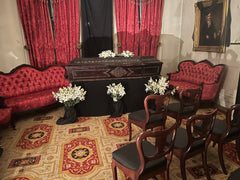
At the Merchant’s House Museum in New York City, Halloween is a true event. This historic house museum is reportedly haunted; October brings ghost tours, special exhibits of mourning jewelry, and death-themed programming. But by far, most visitors find their way to the house to see one thing: the recreation of a 19th-century home funeral.
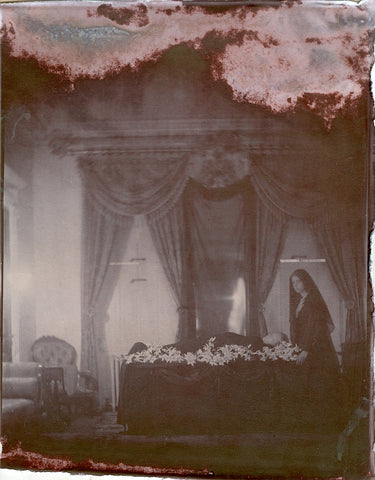
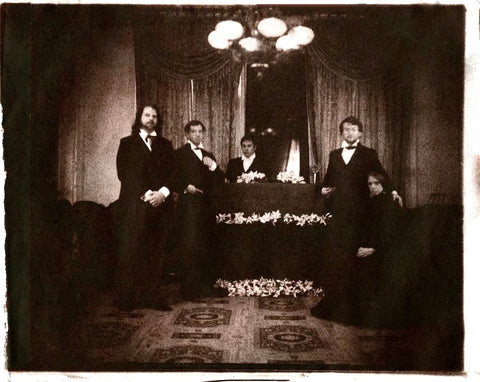
Photo credit: Merchant's House Museum, Hal Hirshorn
In the 19th century, before the funeral industry developed into what we know today, families held funerals at home. Since only the poor went to hospitals, most people died at home, typically surrounded by family and friends in their last hours. Once a person died, they were bathed by either family or servants and laid out in their best clothes so their loved ones could say one last goodbye. Because embalming did not enter the mainstream until after the Civil War, time was of the essence; while the body was laid out, the undertaker (traditionally, at that time, undertakers were furniture or cabinet makers) would come and measure the body and deliver a coffin, its extravagance dependent on the family's social stature and economic class. The body would usually lay out for one day (not only for the family to view, but to ensure that the deceased was actually dead), sometimes on a cooling table packed with ice (to help with preservation), before being placed in the coffin with the lid closed.
The coffin was then taken down to the parlor, a formal room where the family hosted guests – and funerals.
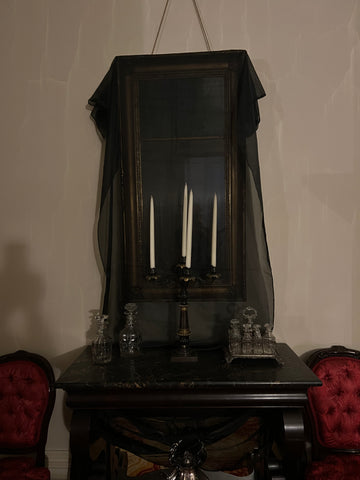
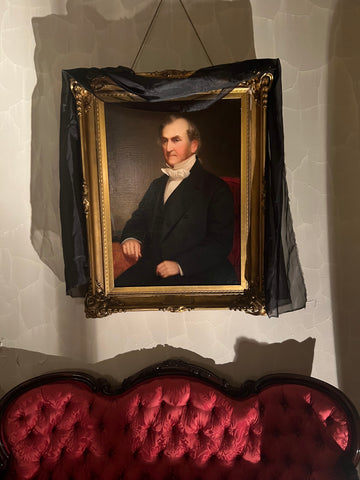
Photo credit: Merchant's House Museum
Funeral notices were placed in newspapers, and a black funeral wreath was hung on the front door. Typically, the coffin would be surrounded by lilies or another strong-smelling flower; the scent hid the smell of any decomposition. Black crepe would be hung on pictures of the deceased, and mirrors would be fully covered in the same material; superstition in the 19th century warned that any reflection seen in a mirror of the dead would lead to the seer's death. Some families would stop all the clocks in the house when the deceased died. A wake would be held for three days before the funeral service; those that came to pay their respects would receive special "funeral biscuits." After the service, the coffin and the family would be processed to the cemetery, the deceased would be buried, and the formal mourning period would begin.
Funeral Biscuits
- One cup of molasses.
- Half a cup of sugar.
- Half a cup of butter.
- Half a cup of warm water, the butter melted with it. A small teaspoonful of pearlash, dissolved in the water.
- Two tablespoons of ginger.
- Caraway seeds.
- Sufficient flour to roll out.
Funeral biscuits were given out at the end of funerals for mourners to take home as a remembrance of the deceased, or sent to those who were unable to attend the funeral. They were wrapped in white paper and sealed with black wax. Some were printed with the deceased's name and date of death, or lines from hymns or Bible verses.
The Role of the Undertaker
It was during the 19th century that some cabinet makers began to take responsibility for helping families with home funerals. In Cleveland, Ohio, the 1857 City Directory lists 16 cabinet makers, 10 of whom also functioned as undertakers. The name “undertaker” developed out of the various duties these cabinet makers would ‘undertake’ to prepare the deceased and the family for the funeral and burial. In addition to delivering coffins, they would provide the families with funeral wreaths and the necessary black crepe to dress the home. After Abraham Lincoln’s funeral brought embalming into the mainstream and embalming schools opened throughout the country, most new undertakers came to the profession through embalming rather than cabinet making. While funerals were still held in the home, undertakers trained as embalmers would bring their embalming equipment to the home and embalm the deceased there. They provided chairs that would be set up in the family's parlor and began to sell mourning dress, memorial books, and other accessories. For more lavish funerals, they provided horses and carriages to transport the body to the cemetery; otherwise, if the distance between the home and the cemetery was not too great, the coffin would be carried by family members and the undertaker’s staff.
Embalming made it possible for the time between the death and the funeral to be extended, and gradually, undertakers (now calling themselves funeral directors) created their own “parlors” in their places of business, where longer wakes could be held to accommodate family and friends who arrived from far away. It appealed to families to move the dead out of their homes into what Frank E. Campbell, one of New York City’s first funeral parlors, called "slumber rooms." Having the funeral outside the home also meant that wakes could be more extensive, and more guests could attend wakes and funeral services held in the beautiful, tastefully decorated facilities funeral directors began to build.
This transition of the funeral from the home to the funeral director's place of business also led to the death of the formal 'parlor' in many American homes. In 1910, the Ladies' Home Journal re-christened the parlor the 'living room,' returning it to the family for their enjoyment. Funerals remained outside the home for the rest of the 20th century, but there is increasing interest in holding funerals at home again, although they will certainly take a different form to home funerals in the 19th century.

